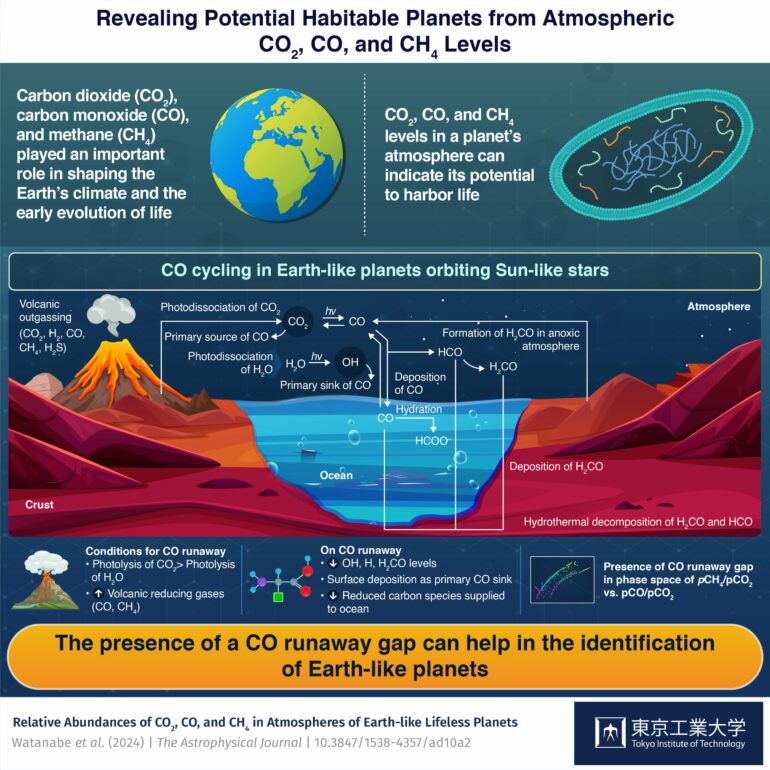The search for habitable exoplanets involves looking for planets with similar conditions to the Earth, such as liquid water, a suitable temperature range and atmospheric conditions. One crucial factor is the planet’s position in the habitable zone, the region around a star where liquid water could potentially exist on the planet’s surface.
NASA’s Kepler telescope, launched in 2009, revealed that 20–50% of visible stars may host such habitable Earth-sized rocky planets. However, the presence of liquid water alone does not guarantee a planet’s habitability. On Earth, carbon compounds such as carbon dioxide (CO2), methane (CH4), and carbon monoxide (CO) play a crucial role in shaping the climate and biogeochemistry and could have contributed to the emergence of life.
Taking this into consideration, a recent study by Associate Professor Kazumi Ozaki from the Tokyo Institute of Technology, along with Associate Researcher Yasuto Watanabe from The University of Tokyo, aims to expand the search for habitable planets. Published in The Astrophysical Journal, the researchers used atmospheric modeling to identify conditions that could result in a CO-rich atmosphere on Earth-like planets that orbit sun-like (F-, G-, and K-type) stars.
This phenomenon, known as CO runaway, is suggested by atmospheric models to have possibly occurred in early planetary atmospheres, potentially favoring the emergence of life.
“The possibility of CO runaway is critical in resolving the fundamental problem regarding the origin of life on Earth because various organic compounds suitable for the prebiotic chemistry are more likely to form in a CO-rich atmosphere than in a CO2-rich atmosphere,” explains Dr. Ozaki.
The researchers modeled the CO cycle between the atmosphere and the oceans, considering the various sources of CO production, its transport mechanisms, and the processes involved in its removal. The photolysis of CO2, in which CO2 breaks down into CO when exposed to light, was considered the primary source of CO.
Additional sources included photochemical reactions in the atmosphere, emissions from volcanic gases, and the hydrothermal decomposition of formaldehyde (H2CO) in the ocean. The removal of CO from the atmosphere primarily occurred through its reaction with hydroxyl (OH) radicals formed due to the photolysis of water vapor, and to a lesser extent, by deposition to the planet’s surface.
The researchers found that a CO runaway occurs when the CO production surpasses the removal by OH radicals. This can occur due to higher CO2 levels or the presence of reducing gases from volcanoes that compete for the OH radicals. At a temperature of 277 K, conditions for CO runaway are met when the partial pressure of CO2 exceeds 0.2 bar.
However, at higher temperatures (300 K), a CO runaway needs even higher CO2 and volcanic gas levels due to increased water vapor in the atmosphere, which is a major source of OH radicals. Once initiated, the CO levels in the atmosphere are limited only by surface deposition, where CO is deposited onto the planet’s surface.
Notably, the changes in the CO, CO2 and CH4 levels before and after the runaway effect led to a gap reflected in the phase space defined by the ratios of their partial pressures (pCO/pCO2 and pCH4/pCO2).
“Our results suggest that this CO-runaway gap is a general feature of Earth-like lifeless planets orbiting sun-like stars, providing insights into the characteristics and potential habitability of exoplanets,” says Dr. Ozaki.
Although the exact conditions that lead to the emergence of life remain uncertain, discoveries like the CO-runaway gap provide valuable clues in our quest to find habitable planets that could facilitate the origin of life among nearly 40 billion Earth-size planets orbiting sun-like stars in the Milky Way galaxy.
More information:
Yasuto Watanabe et al, Relative Abundances of CO2, CO, and CH4 in Atmospheres of Earth-like Lifeless Planets, The Astrophysical Journal (2024). DOI: 10.3847/1538-4357/ad10a2
Provided by
Tokyo Institute of Technology
Citation:
Newly discovered carbon monoxide-runaway gap can help identify habitable exoplanets (2024, February 6)



